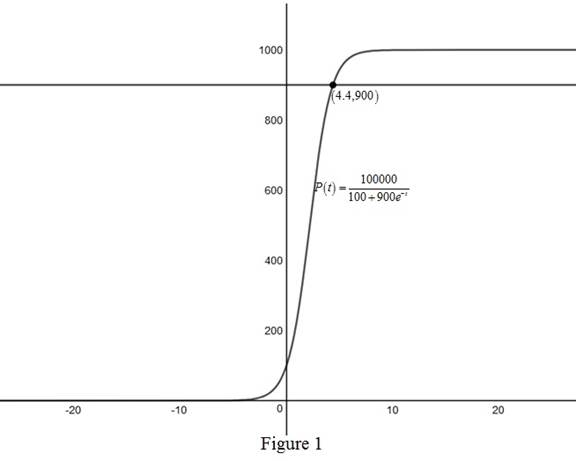
Concept explainers
The population of a certain species in a limited environment with initial population 100 and carrying capacity 1000 is
where t is measured in years.
(a) Graph this function and estimated how long it takes for the population to reach 900.
(b) Find the inverse of this function and explain its meaning.
(c) Use the inverse function to find the time required for the population to reach 900. Compare with the result of part (a).
(a)
To estimate: The time taken in which the population reaches 900 with the help of graph of the given equation.
Answer to Problem 28RE
Solution:
The time taken in which the population to reach 900 is approximately 4.4 years.
Explanation of Solution
Given:
The initial population in an limited environment is 100 with the carrying capacity 1000.
Also the population at any instant of time t is,
Graph:
Use online graph calculator and draw the graph of the function

From Figure1,obtain that point of intersection of the graph of
Therefore, time taken by the population to reach 900 is approximately 4.4 years.
(b)
To find: The inverse of the given function and to explain its meaning.
Answer to Problem 28RE
Solution:
The inverse of the function is
Explanation of Solution
Calculation:
Let
Again solve the above equation,
Take reciprocal on both sides,
Take natural logarithm on both sides,
Since
Therefore,
Where t is the inverse of the function and t denotes the time taken by the population to reach P.
(c)
To find: The time required by the population to reach 900 by using the inverse function.
Answer to Problem 28RE
Solution:
The time required for the population to reach 900 by using the inverse function is approximately 4.39 years.
Explanation of Solution
Calculation:
From part(b), the inverse of the function is
Given that
Therefore, the inverse of the function is,
Thus, the time required for the population to reach 900 by using the inverse function is approximately 4.39 years.
Compare this answer with the answer in part (b) and observe that the answers are approximately same.
Chapter 1 Solutions
Single Variable Calculus: Concepts and Contexts, Enhanced Edition
Additional Math Textbook Solutions
Finite Mathematics and Calculus with Applications (10th Edition)
University Calculus
Precalculus
Calculus & Its Applications (14th Edition)
Calculus: Single And Multivariable
 Calculus: Early TranscendentalsCalculusISBN:9781285741550Author:James StewartPublisher:Cengage Learning
Calculus: Early TranscendentalsCalculusISBN:9781285741550Author:James StewartPublisher:Cengage Learning Thomas' Calculus (14th Edition)CalculusISBN:9780134438986Author:Joel R. Hass, Christopher E. Heil, Maurice D. WeirPublisher:PEARSON
Thomas' Calculus (14th Edition)CalculusISBN:9780134438986Author:Joel R. Hass, Christopher E. Heil, Maurice D. WeirPublisher:PEARSON Calculus: Early Transcendentals (3rd Edition)CalculusISBN:9780134763644Author:William L. Briggs, Lyle Cochran, Bernard Gillett, Eric SchulzPublisher:PEARSON
Calculus: Early Transcendentals (3rd Edition)CalculusISBN:9780134763644Author:William L. Briggs, Lyle Cochran, Bernard Gillett, Eric SchulzPublisher:PEARSON Calculus: Early TranscendentalsCalculusISBN:9781319050740Author:Jon Rogawski, Colin Adams, Robert FranzosaPublisher:W. H. Freeman
Calculus: Early TranscendentalsCalculusISBN:9781319050740Author:Jon Rogawski, Colin Adams, Robert FranzosaPublisher:W. H. Freeman
 Calculus: Early Transcendental FunctionsCalculusISBN:9781337552516Author:Ron Larson, Bruce H. EdwardsPublisher:Cengage Learning
Calculus: Early Transcendental FunctionsCalculusISBN:9781337552516Author:Ron Larson, Bruce H. EdwardsPublisher:Cengage Learning





